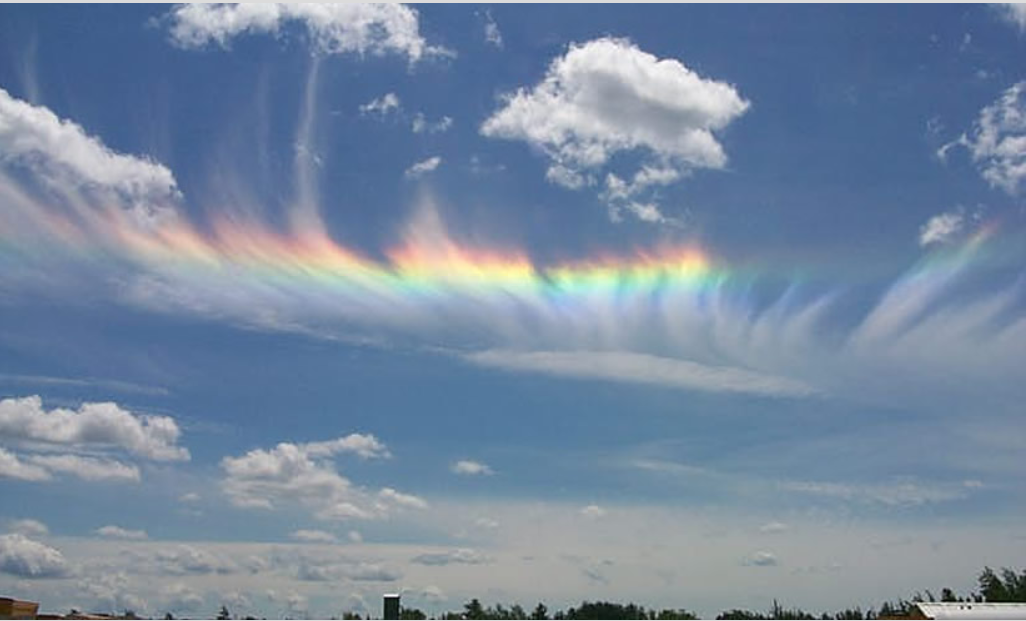Circumhorizon Arc
The Phenomenon of Circumhorizon Arc
Have you ever looked up at the sky on a sunny day and noticed a vibrant, colorful arc spanning across the horizon? This stunning optical phenomenon is known as the circumhorizon arc, sometimes referred to as a circumhorizontal arc. Contrary to its popular but incorrect name, "fire rainbow," the circumhorizon arc has nothing to do with fire or rainbows. In this article, we will delve deeper into this fascinating atmospheric optics phenomenon and explore its characteristics, visibility, and geographic distribution.
Characteristics of the Circumhorizon Arc
The circumhorizon arc is a large halo that appears parallel to the horizon when the sun is at an elevation higher than 58°. It is always located beneath the sun and is approximately twice as far from the sun as the more commonly observed 22º halo. This distance can be estimated as about two hand spans. The arc itself is quite expansive, often stretching across a significant portion of the sky.
When cirrus clouds are present, they act as a canvas for the circumhorizon arc, causing it to become fragmented. These fragments of the arc are then illuminated with brilliant colors, resembling iridescence. The vivid hues displayed by the circumhorizon arc are pure spectral colors, creating a breathtaking spectacle for those fortunate enough to witness it.
Visibility and Rarity
The visibility and rarity of the circumhorizon arc vary depending on geographical location. In regions with medium latitudes, such as much of the United States, this phenomenon is not uncommon and can be observed several times during the summer months. However, as one moves further north towards Europe, the circumhorizon arc becomes increasingly rare. In fact, it is impossible to see it north of Copenhagen in most parts of Europe.
To determine the likelihood of witnessing this awe-inspiring spectacle in your area, charts detailing its visibility at various locations can be consulted. These charts provide valuable information on the frequency of occurrence, allowing enthusiasts to plan their observations accordingly.
Distinguishing the Circumhorizon Arc
It is important to note that the circumhorizon arc can sometimes be confused with another atmospheric optics phenomenon known as the high sun infralateral arc. While the circumhorizon arc remains parallel to the horizon, the infralateral arc curves slightly upwards from the horizon. Visual observation is key to distinguishing between these two phenomena, as lens distortions can often make the circumhorizon arc appear curved as well.
The Misnomer: "Fire Rainbow"
The term "fire rainbow" is a misnomer that gained popularity after a particularly remarkable display of the circumhorizon arc in Spokane in 2006. Coined by a journalist, this name is misleading, as the halo has no connection to fire or rainbows. It is essential to use the correct term, circumhorizon arc, to accurately describe this fascinating atmospheric phenomenon.
In conclusion, the circumhorizon arc is a captivating optical display that graces the skies on sunny days with cirrus clouds. Its vibrant colors and enormous size make it a sight to behold for those fortunate enough to witness it. While more common in medium latitudes, its rarity in certain regions adds to its allure. So, keep an eye on the sky when the sun is high, and you may just catch a glimpse of this extraordinary atmospheric optics phenomenon!

Summertime Halo: A colourful circumhorizon arc spans the sky near Fredericton, New Brunswick, Canada. The halo lights brightest where the cirrus is thickest. Note the enormous size of the halo and its pure spectral colours. Imaged by Marc Sorensen in the summer of 2003. Image ©Marc Sorensen, shown with permission.
Look for the brightly coloured circumhorizon arc (also a circumhorizontal arc but never 'fire rainbow') when the sun is very high in the sky - higher than 58°. Near to noon in mid summer is a good time in middle latitudes. The halo is beneath the sun and twice as far from it (two hand spans) as the 22º halo.
It is a very large halo and always parallel to the horizon. Often only fragments are visible where there happen to be cirrus clouds - the individual patches of cirrus are then lit with colour that can be mistaken for iridescence.
High sun infralateral arcs occupy a similar position in the sky. The infralateral arc curves upwards from the horizon slightly and this is best checked for visually because lens distortions invariably also show the circumhorizon arc as curved.
The rarity, or otherwise, of the arc depends on where you are. At medium latitudes like much of the USA it is not rare - it can be seen several times each summer. In contrast, further north in much of Europe the circumhorizon arc is a rarity and impossible to see north of Copenhagen. See the charts in 'How rare?' for the visibility at your location.
.. 'Fire rainbow' - This unrecognised name appears to have been coined by a journalist after the great 2006 Spokane display. The halo is not a rainbow and has nothing to do with fire.
Note: this article has been automatically converted from the old site and may not appear as intended. You can find the original article here.
Reference Atmospheric Optics
If you use any of the definitions, information, or data presented on Atmospheric Optics, please copy the link or reference below to properly credit us as the reference source. Thank you!
-
<a href="https://atoptics.co.uk/blog/circumhorizon-arc/">Circumhorizon Arc</a>
-
"Circumhorizon Arc". Atmospheric Optics. Accessed on April 27, 2024. https://atoptics.co.uk/blog/circumhorizon-arc/.
-
"Circumhorizon Arc". Atmospheric Optics, https://atoptics.co.uk/blog/circumhorizon-arc/. Accessed 27 April, 2024
-
Circumhorizon Arc. Atmospheric Optics. Retrieved from https://atoptics.co.uk/blog/circumhorizon-arc/.